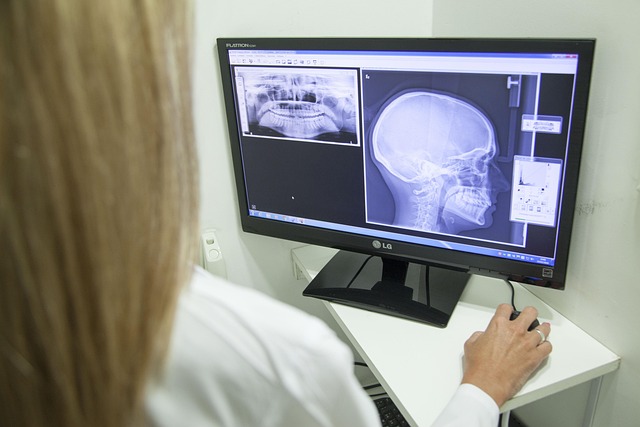Radiographic contrast media, like ionic and nonionic agents, enhance medical imaging visibility but carry risks of allergic reactions ranging from mild to life-threatening anaphylaxis. They can also cause side effects such as gastrointestinal distress and renal dysfunction. Safe administration requires healthcare professionals to screen patients for allergies, prepare them adequately (including hydration and informed consent), manage anxiety, and monitor closely for adverse reactions.
Radiographic contrast media play a crucial role in enhancing medical imaging, aiding in accurate diagnosis. However, their use isn’t without risks; allergic reactions and side effects can occur, ranging from mild discomfort to severe, life-threatening responses. This article delves into the world of radiographic contrast media, exploring its types, common allergic reactions, potential side effects beyond allergies, and safety measures to mitigate risks during procedures involving this media. Understanding these aspects is vital for both medical professionals and patients alike.
Understanding Radiographic Contrast Media: Its Role and Types
Radiographic contrast media plays a crucial role in enhancing the visibility of internal structures during medical imaging procedures like X-rays, CT scans, and MRI. It works by increasing the density difference between tissues or organs, allowing for better distinction on radiological images. This contrast agent is administered intravenously or orally, depending on the examination type.
There are various types of radiographic contrast media, including ionic and nonionic agents. Ionic contrast media, such as iodinated substances, work by increasing the density of body tissues. Nonionic agents, like gadolinium derivatives, have a different mechanism, improving blood flow visibility in imaging. Understanding these differences is essential for healthcare professionals to choose the appropriate agent based on the specific diagnostic needs and patient conditions.
Common Allergic Reactions to X-ray Contrast Media
Common allergic reactions to radiographic contrast media can range from mild to severe. Some patients may experience skin rashes, itching, or hives after exposure to the dye. These symptoms are usually immediate and can be treated with antihistamines or corticosteroids. More serious reactions, though rare, can include difficulty breathing, swelling of the face or throat, and anaphylaxis. These severe responses require emergency medical attention.
The severity of allergic reactions is often dependent on the type of radiographic contrast media used and individual sensitivity. Some individuals may have a history of allergies to other substances and be at higher risk for reacting negatively to the dye. It’s crucial for healthcare providers to be aware of any such allergies before administering radiographic contrast media to ensure patient safety.
Potential Side Effects Beyond Allergies
While allergies are a common concern, there are other potential side effects associated with radiographic contrast media that should be considered. These adverse reactions can vary in severity and may include gastrointestinal disturbances like nausea or vomiting, headaches, dizziness, and even cardiovascular impacts such as changes in blood pressure or heart rhythm. These symptoms often arise due to the body’s physiological response to the foreign substance, leading to inflammation or vasodilation.
In some cases, more serious complications can occur, particularly with high-risk individuals or when larger doses are administered. These rare but significant side effects may encompass renal dysfunction, allergic arthralgia (joint pain), and even acute respiratory distress syndrome (ARDS). Prompt medical attention is crucial if any severe symptoms manifest during or after exposure to radiographic contrast media.
Mitigating Risks: Safety Measures and Patient Preparation
To mitigate risks associated with radiographic contrast media, several safety measures and patient preparation steps are crucial. Before administration, healthcare providers should thoroughly review a patient’s medical history to identify any known allergies or conditions that could be exacerbated by the media. This includes assessing for pre-existing respiratory diseases, kidney function, and any previous reactions to similar agents.
Patient preparation is paramount. Informed consent, emphasizing potential side effects, should be obtained. Adequate hydration is encouraged to minimize the risk of renal complications. In some cases, pre-medication with antihistamines or corticosteroids may be prescribed to reduce the likelihood of allergic reactions. Additionally, ensuring a calm and comfortable environment can help manage anxiety, which itself can contribute to adverse effects.
Understanding the potential risks associated with radiographic contrast media is essential for both healthcare professionals and patients. While rare, allergic reactions and side effects can occur, knowing the signs and implementing safety measures can help mitigate these risks effectively. By being proactive in patient preparation and staying informed about different types of contrast media, medical staff can ensure a safer imaging experience, reducing anxiety and improving patient outcomes. This comprehensive approach to managing radiographic contrast media is vital for navigating the delicate balance between diagnostic accuracy and patient safety.
